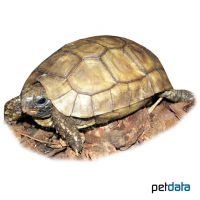Bell’s Hingeback Tortoise (Kinixys belliana)
| Bell’s Hingeback Tortoise Kinixys belliana | |
|---|---|
| Name | Bell’s Hingeback Tortoise |
| Name Lat. | Kinixys belliana |
| Family | Tortoises |
| Family lat. | Testudinidae |
| Order | Turtles |
| Order lat. | Testudines |
| Origin | Africa |
| Habitat | Savanna |
| Diet | Herbs, veggies, earthworms |
| Humidity | 40-60 % |
| Behavior | ♂ territorial |
| Keeping | Individual, harem |
| Care Level | Difficult |
| Reproduction | Oviparous |
| Housing | Dry terrarium |
| Life Span | 20-25 years |
| Protection | CITES Appendix II; EU Annex B |
| Metric Units | |
| Size | 22 cm |
| Temperature | 25-28 °C |
| Temperature Local | 35-45 °C |
| Housing Size | 200 x 100 x 50 cm |
| US Units | |
| Size | 8.7" |
| Temperature | 77-82 °F |
| Temperature Local | 95-113 °F |
| Housing Size | 80" x 40" x 20" |
Distribution and habitat
The diurnal to crepuscular smooth-edged tortoises are widespread in West Africa (Senegal, Cameroon) and in Eastern Africa (South Sudan, Ethiopia, Kenya) but also in Madagascar. There they live in the dry as well as in the humid savannas and in forest areas.
Maintenance
Minimum dimensions for the terrarium, according to the size and number of animals
| 1-2 animals | 8PL x 4PL (L x W) |
The carapace length (PL) is measured on the largest animal. For each additional animal the footprint has to be increased by10 %, from the 5th animal on by 20 %. A terrarium of e.g.200 x 100 x 50 cm is recommended, which should be placed in a quiet and vibration-free place.
They need a terrarium structured with branches, large plants and stones, with a graveable substrate, e.g. of sand-loam-peat mixture, as well as an easy to clean, large water basin as drinking and bathing possibility. A small part of the substrate should always be kept slightly moist. In the case of group housing, separate retreats (visual separation) should be provided. For 3-4 months (rainy season) the humidity should be increased significantly. A rain system is ideal.
| Temp. day: 25-28 °C | Temp. night: 18-22 °C | Temp. local: 35-45 °C | Humidity: 40-60 |
Thermostatically controlled floor heating is recommended. Lighting duration must be 10-14 hrs, depending on the season. They need high light intensity and daily UV irradiation as well as sunny places with radiant heat.
Diet
They are omnivores, but they feed almost exclusively vegetarian. The diet consists of a wide range of wild herbs (plantain, dandelion, parsley, etc.), grass, hay and hay dressings, clover, sweet grasses, mushrooms and vegetables such as lettuce, spinach, cabbage leaves, cucumbers, zucchini and carrots, supplemented with commercial ready-made food for tortoises. Occasionally they require small amounts of animal protein, such as earthworms, snails or grasshoppers, and small pieces of hard-boiled egg. Fruit should be fed sparingly and infrequently because of the fructose content. It is important to regularly add minerals and vitamins as well as cuttlebone. Drinking water (drunk through the nose) must always be available. They drink a lot and like to bathe.
A varied diet promotes health and prevents deficiency symptoms.
Reproduction and breeding
Males have a concave ventral carapace (plastron) and a much longer tail. Mating occurs year-round, but cooler months are preferred. Egg laying occurs 2-3 times a year. The female buries her eggs, a maximum of 7 per clutch, in a southeast facing location. The incubation period is 90-110 days at an average of 30 °C.
Life expectancy can be 20-25 years.
Species protection
The animal population must be reported in writing to the competent authority immediately after the start of keeping. Subsequently, all arrivals and departures must be reported.
Protection of species: WA Annex II; EU Annex B. The proof of purchase is the required proof of origin for the animal. Please keep it safe! Your pet store will be happy to provide you with further information.
Important
They are not very active turtles, often living hidden under fallen leaves. During the dry season they keep a summer rest. Their stilted gait is conspicuous, as they are toe walkers. Males are very incompatible with each other. Breeding is considered complicated because many eggs die during embryonic development or are not fertilized at all.
The terrarium must have good ventilation without drafts and meet the species specific needs. Measuring devices such as thermometers, hygrometers, etc. are necessary. The lighting has to correspond to the species-specific day-night rhythm and has to be placed in such a way that the animals cannot injure themselves. The terrarium should be locked in such a way that neither unauthorized persons can open it nor the animals can escape. Contamination must be removed regularly
Further literature can be found in your pet store.
References
Text: Christian Sänger; Image: petdata
Source: BMELV (1997): Tierschutzgutachten - Mindestanforderungen an die Haltung von Reptilien; ENGELMANN (2006): Zootierhaltung - Tiere in menschlicher Obhut: Reptilien und Amphibien, Harri Deutsch Verlag
- Gemäß § 21 Abs. 5 Tierschutzgesetz idgF
